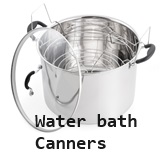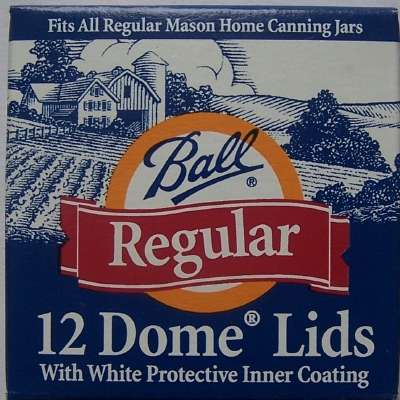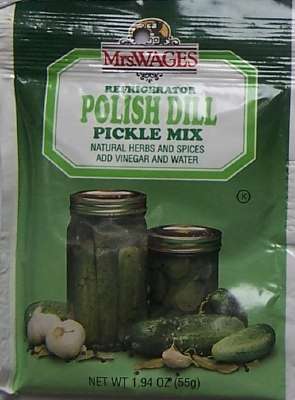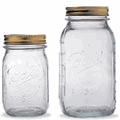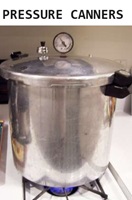Looking for Canning Beets FAQs: Problems, Questions and Answers About Canning Beets in 2025? Scroll down this page and follow the links. And if you bring home some fruit or vegetables and want to can, freeze, make jam, salsa or pickles, see this page for simple, reliable, illustrated canning, freezing or preserving directions. There are plenty of other related resources, click on the resources dropdown above. If you are having a hard time finding canning lids, I've used these, and they're a great price & ship in 2 days.
If you have questions or feedback, please let me know! There are affiliate links on this page. Read our disclosure policy to learn more.
Canning Beets FAQs: Problems, Questions and Answers About Canning Beets
Canning Beets FAQs:
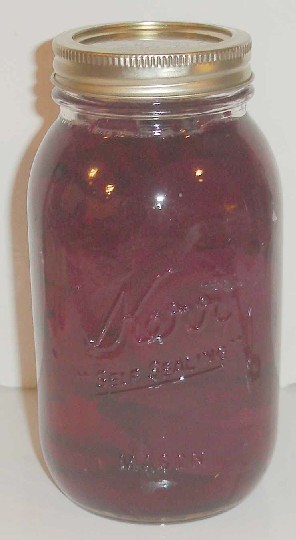 Problems,
Questions and Answers About Canning Beets
Problems,
Questions and Answers About Canning Beets
Canning beets (with a Pressure Canner, as is necessary and required for all low acid foods) is prrett easy. Here are the common issues that can arise nonetheless, and how to solve them!
Reminder:. Beets are a low acid food, so you cannot use a water bath canner . It must be a pressure canner. (of course, pickled beets can be canned in a water bath canner, because ac id , in the form of vinegar, is added)Pressure canners cost more than water bath canners, but they are more versatile and last a lifetime, and your children and grandchildren may be using it. I've had mine for 20 years and it looks good for another 50 years. See this page for more information about pressure canners.
See this FAQ for more details: Can I use a water-bath canner instead of a Pressure Canner for low acid foods?
Frequently Asked Questions
- Fading color,: "Last
night I canned my beets, but when I pulled them out of the pressure
cooker, it looked like they were white and the liquid was red. What
would of caused this. I am new to canning this year. So any tips
would be good! Thank you"
Beets might look pale red, washed out, yellow or pink after canning. The taste, safety and quality of the beets isl not affected.
This can be due to the variety of the beets. Detroit Dark Red and Ruby Queen are two dark pigmented varieties that should retain color.
To help retain the color, leave an inch of the stem and roots on the beets when they are cooked. After cooking, slip skins off and remove top and stem.
Acidity also helps to retain the red color. Adding a teaspoon of vinegar, lemon juice or citric acid to each jar usually helps.
Presto (maker of pressure canners) also says that the loss of color from beets during canning may also be due to beets that are too old. If possible, can young, tender, very dark red beets which are freshly gathered.
Precooking beets with 2 inches of the stem and all of the root on also helps to retain the juices. So, leave two inches of stem and tap root attached to the beets before boiling to remove the skins. Then trim the stem and root and slice, dice or leave whole for canning.
- Is it safe to can beets in a traditional water bath? If so how
long do you do process them?
The answer, quite simply is no; you may not can beets in a boiling water bath (you MAY can "pickled beets" in a waterbath, but that is a different recipe!) Quoting from the Ohio State University Extension's Fact Sheet:
"Pressure canning is the only safe method for home canning vegetables. Clostridium botulinum is the bacterium that causes botulism food poisoning in low-acid foods, such as vegetables. The bacterial spores are destroyed only when the vegetables are processed in a Pressure Canner at 240 degrees Fahrenheit (F) for the correct amount of time.Clostridium botulinum is the bacterium commonly found in vegetables and meats. It is harmless until it finds itself in a moist, low-acid, oxygen-free environment or a partial vacuum. Under these conditions, the bacterium can grow and produce toxins dangerous to people and animals.
Do not process (low acid) vegetables using the boiling water bath because the botulinum bacteria can survive that method.
Pressure canners!If you want to can low-acid foods such as red meats, sea food, poultry, milk, and all fresh vegetables with the exception of most tomatoes, you will need a Pressure Canner. These foods fit into the low acid group since they have an acidity, or pH level, of 4.6 or greater. The temperature which must be reached and maintained (for a specified amount of time) to kill the bacteria is 240 F. Pressure canning is the only canning method recommended safe by the U.S.D.A. for low-acid foods such as vegetables, meats, and fish. Ordinary water bath canners can only reach 212 F and cannot to kill the types of bacteria that will grow in low acid foods. This temperature can be reached only by creating steam under pressure as achieved in quality pressure canners. There are several manufacturers of pressure canners. The two leading ones are Presto and All American (Wisconsin Aluminum). They are more expensive than water bath canners, but extremely well built - I bought mine in 1988 and it still looks and works like new! |
|
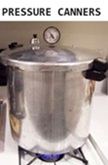
|
Presto 01781 23-Quart Pressure Cooker/CannerThis is one of the least expensive but reliable pressure canners available. I've been using mine for 30 years! There is also a 16 quart version for even less. . Click on the links at left or above for more info and current pricing. Click on the box at left for more information. See the seller's website for features, pricing and user reviews!
|
|
|
See the seller's website for features, pricing and user reviews! |
| All-American 941 Pressure Canner All-American 930 Pressure Canner |
All American Pressure Canner and Cookers - In 3 SizesSee the seller's website for features, pricing and user reviews! |
Lids, Rings, Jars, mixes, pectin, etc.Need lids, rings and replacement jars? Or pectin to make jam, spaghetti sauce or salsa mix or pickle mixes? Get them all here, and usually at lower prices than your local store! |

|
BUT, with a Pressure Canner it's easy. And although a pressure canner costs $100 to $200 (see this page for pressure canners models, makes and prices), they last a lifetime, and your children and grandchildren may be using it. You can also find free information from the USDA in this PDF file (it will take a while to load!) about selecting and using canners here! |
Can't find the equipment? We ship to all 50 states!
This page was updated on
Looking for canning equipment and supplies?
Water bath canner with a jar rack
Pressure canners for gas, electric and induction stoves: Presto 23Qt or T-fal 22Qt
Canning scoop (this one is PERFECT)
Ball Blue book (most recent version)
Jars: 8oz canning jars for jams
Find Other types of farms:
Farm markets and roadside stands
Road trips and camping resources
Local Honey, apiaries, beekeepers
Consumer fraud and scams information
Home canning supplies at the best prices on the internet!
Maple Syrup Farms, sugarworks, maple syrup festivals
Environmental information and resources
Farms For Your Event for birthday parties, weddings, receptions, business meetings, retreats, etc.
Festivals - local fruit and vegetable festivals
Get the
most recent version of
the Ball Blue Book
With this Presto 23 quart pressure canner and pressure cooker, you can "can" everything, fruits, vegetables, jams, jellies, salsa, applesauce, pickles, even meats, soups, stews. Model 01781

You can make jams, jellies, can fruit, applesauce, salsa and pickles with water bath canners, like this Granite Ware 12-Piece Canner Kit, Jar Rack, Blancher, Colander and 5 piece Canning Tool Set
